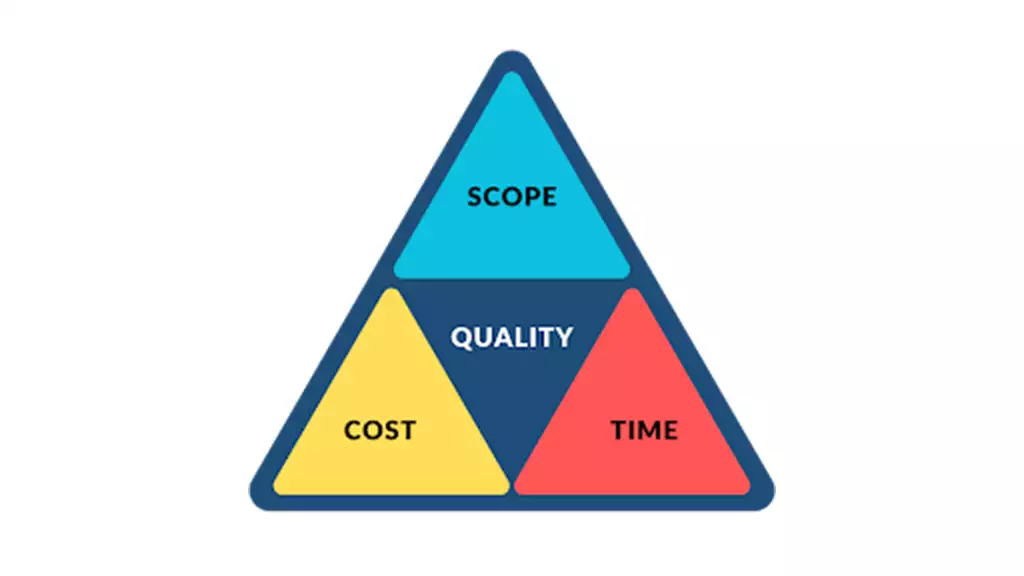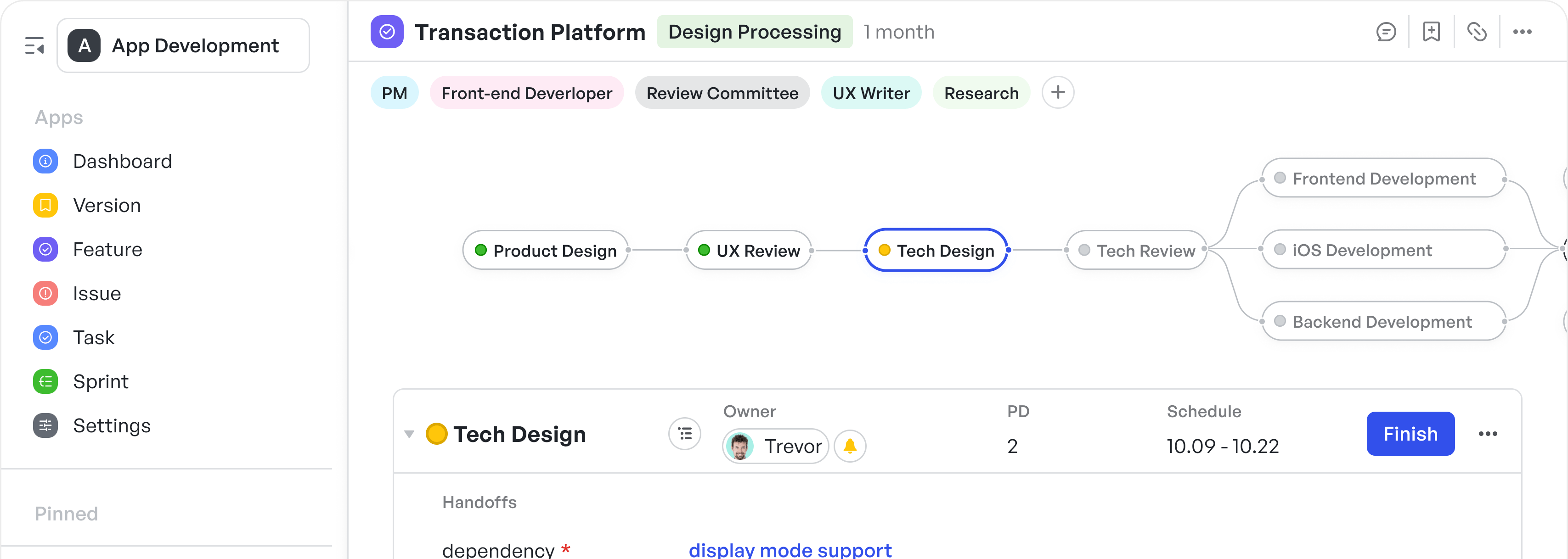The Project Management Triangle is a simple yet powerful concept that helps project managers navigate complex resource trade-offs.
We are going to elaborate on this below, but here’s a brief description of what the Project Management Triangle is, to prime you for the rest of the article:
The Project Management Triangle illustrates the fundamental constraints of a project manager's job. It consists of three key elements:
- Scope: The specific goals, deliverables, features, and functions of the project.
- Time: The project schedule, including deadlines and milestones.
- Cost: The budget and resources allocated to the project.

250px|700px|reset
The core idea is that changing one side of the iron triangle inevitably affects at least one of the others in the project management body.
Why is visualizing this important?
When faced with competing demands, this model can help you understand the implications of your choices and make informed decisions about trade-offs.
In fact, if you don’t want to make any trade-offs, the triangle is an excellent tool for explaining project constraints to stakeholders. It clearly illustrates that you can't have it all—faster, cheaper, and better—without making trade-offs.
Let’s get into a more detailed explanation of the Project Management Triangle and how you can make it work for you.
Understanding the Three Constraints
We know that the Project Management Triangle consists of three interdependent constraints: scope, time, and cost.
Scope
Scope encompasses everything that needs to be done to deliver a project successfully, i.e., the work required to complete it.
It's the 'what' of your project management lifecycle.
The key components of this element are:
- The overarching aims of the project
- Specific, measurable outcomes you want to achieve
The deliverables and features are usually: tangible products or services to be produced or specific functionalities or characteristics of these deliverables. It would ideally also include standards that the project quality must meet as well as performance criteria for deliverables.
Time
Time refers to the duration of the project and the schedule for completing each task, i.e., the project schedule and deadlines. It's the 'when' of your project.
Key aspects include:
- Overall duration of the project
- Start and end dates for each phase
- Key checkpoints throughout the project
- Specific dates by which certain deliverables must be completed
- When team members and other resources are available to work on tasks
- Any constraints on resource availability (e.g., holidays, other project commitments)
Cost
Cost includes all the resources required to complete the project, i.e., the project's budget and resources allocated. It's the 'how much' of your project.
Key elements include:
- Total funds allocated to the project
- Breakdown of costs for different project components
- Team members assigned to the project
- Their time allocation and associated costs
- Physical resources needed for the project
- Software licenses or other non-physical assets
The Interrelationship Between Constraints
The Project Management Triangle is not just about understanding each constraint individually, but also recognizing how they interact with each other. This interplay is crucial for successful project management.
How Changing One Constraint Affects the Others
When you adjust one side of the triangle, it inevitably impacts at least one of the others. Here are some examples:
Increasing Scope
- Time Impact: More work usually requires more time to complete.
- Cost Impact: Additional features or deliverables often increase project costs.
Reducing Time
- Scope Impact: You might need to cut features to meet a tighter deadline.
- Cost Impact: Accelerating the schedule might require additional resources, increasing costs.
Cutting Costs
- Scope Impact: You may need to reduce deliverables or features to stay within budget.
- Time Impact: Using fewer resources might extend the project timeline.
The "Pick Two" Concept
Project managers often talk about the need to "pick two" constraints to prioritize. The idea is that you can optimize for two constraints, but the third will need to flex. For example:
- Fast and cheap, but potentially lower quality
- Fast and high quality, but potentially more expensive
- High quality and cheap, but potentially slower
This concept introduces quality as a fourth factor, often represented as the center of the triangle. Quality is influenced by how you balance the other three constraints.
The Project Management Triangle in Different Methodologies
The Project Management Triangle is a universal concept, but its application varies depending on the project management methodology used.
250px|700px|reset
加载中,请稍后
Let's explore how it applies to different approaches:
Waterfall Project Management
In the traditional Waterfall approach, the project progresses sequentially through distinct phases. The scope is typically defined upfront and remains fixed, with time estimated for each phase at the project's start. Costs are budgeted based on the initial scope and timeline.
The triangle in Waterfall often emphasizes maintaining the original scope, with changes being costly and time-consuming. Quality is usually monitored at the end of each phase. This approach works well for projects with well-defined requirements and minimal expected changes.
Agile Methodologies
Agile approaches prioritize flexibility and iterative development. In this methodology, the scope is fluid and adjusted throughout the project, while time is fixed in short iterations or sprints. Cost is often fixed, with scope adjusting to fit time and budget constraints.
The triangle in Agile focuses on delivering the highest-value features within time and budget constraints. Scope is the most flexible constraint, allowing teams to adapt to changing requirements or market conditions. Quality is built-in through continuous testing and feedback.
Hybrid Approaches
In hybrid approaches, scope may have fixed core requirements with flexible additional features. Time could have fixed major milestones with flexible interim deadlines, while cost might have a fixed overall budget with flexible allocation.
The triangle in hybrid approaches balances the stability of Waterfall with the flexibility of Agile. It requires careful management of which constraints are fixed versus flexible. This approach can be beneficial for complex projects or those with both stable and evolving elements.
Common Challenges and Solutions
You can face many challenges in the project management process when it comes to maintaining the balance between scope, time, and cost.
Let's explore some common issues and how to address them:
- Identifying and addressing scope creep: Scope creep occurs when project requirements expand beyond the original plan. This can put pressure on both time and cost constraints. To combat this, establish a clear change management process. Use our visual workflow to highlight new or expanded tasks, making it easier to assess their impact on the project triangle.
- Dealing with unexpected delays or cost overruns: Surprises are inevitable in project management. The key is early detection and swift action. Set up automated update system to notify you when tasks are falling behind schedule or when costs are approaching budget limits. This early warning system allows you to address issues before they become critical, perhaps by reallocating resources or adjusting other aspects of the triangle.
- Strategies for maintaining quality under constraint pressures: When time or budget pressures mount, quality can often suffer. To prevent this, integrate quality checks throughout your project process. With Meegle, you can set up approval stages, peer reviews, or testing phases at crucial points in the project, and ensure that quality standards are maintained even as other constraints shift.
Applying the Project Management Triangle with Meegle
Managing Scope with Meegle’s Node-Driven Workflows
In the Project Management Triangle, scope represents the specific goals, deliverables, and requirements of a project. Keeping the project scope well-defined and controlled is essential for avoiding scope creep and ensuring project success.
How Meegle Helps
- Node-Driven Workflow Visualization: Meegle’s visual workflow feature allows you to map out every task, deliverable, and milestone, providing a clear overview of the entire project scope. By breaking down the scope into individual nodes, you can visually track which elements are essential versus nice-to-haves, ensuring that the core deliverables stay in focus.
250px|700px|reset
加载中,请稍后
Visualize and optimize your tasks with Meegle
- Hierachial View of Project Scope: With Meegle's Tree View you can organize the project, features, and issues into a hierarchical, multi-level structure for better management and tracking of project scope
250px|700px|reset
加载中,请稍后
Get the full scope with Meegle's Tree View
Optimizing Time with Meegle’s Scheduling and Time Management Tools
Time management is critical in the Project Management Triangle, representing the duration and deadlines of a project. Managing time efficiently ensures that tasks are completed in the right order, and deadlines are met.
How Meegle Helps
- Tree View with a Gantt Chart for Timeline Management: Meegle’s most helpful feature is the schedule management mode of the Tree View, which allows you to view the entire project timeline as a single view with a Gantt chart to always stay on top of your project timelines.
250px|700px|reset
加载中,请稍后
Visualize your project with Schedule Management mode on the tree view
You can gain a high-level view of the project using this view, which gives you all the key project data on time, status, workload and more. The information is presented in colorful and easy-to-read charts, making it simple to digest.
- Automated Deadline Notifications: To keep teams on track, Meegle provides custom automatic notifications that can be set up for upcoming deadlines, milestones, or overdue tasks. This feature reduces the risk of missed deadlines and helps managers quickly respond to any shifts in the timeline.
250px|700px|reset
加载中,请稍后
Set up automated notifications for custom triggers with Meegle
- Track time at the Node level: For every node in the workflow on Meegle, you can add estimates of time and schedule dates for the personnel who would be working on the tasks associated with the node.
250px|700px|reset
加载中,请稍后
Track time and personnel for every node in a workflow
Managing Costs with Meegle’s Custom Analytics
Teams can monitor key performance metrics that contribute to cost metrics, like staff efficiency, project spend to help refine workflows.
Meegle also has out-of-the-box reporting templates with a high level of customization and flexibility. Pie, line, and bar graphs, as well as many other visualization options.
250px|700px|reset
加载中,请稍后
Harness instant data insights to optimize operations, and capitalize on emerging opportunities
Measuring Success with the Project Management Triangle
Success in project management isn’t just about finishing on time or staying within budget; it’s about balancing scope, time, and cost—the three essential constraints of the Project Management Triangle. Monitoring this balance is key to understanding project health and making adjustments when challenges arise.
Key Performance Indicators (KPIs) to Track Success:
- Scope: Track the percentage of completed project features or deliverables versus what was originally planned. Focusing on essential items helps ensure that the project delivers core value without unnecessary scope expansion.
- Time: Measure task completion rates and monitor for delays to ensure the project remains on schedule. Burn-down charts or milestone reviews can help visualize progress toward deadlines, enabling early interventions if timelines slip.
- Cost: Keep an eye on budget consumption versus the allocated budget. Identifying potential cost overruns early allows for reallocation or scaling back on certain aspects to maintain financial control.
Balance with Meegle
As you apply these concepts to your projects, keep in mind that effective management of the Project Management Triangle is an ongoing process. It requires constant monitoring, clear communication, and the ability to adjust your approach as circumstances change.
Tools like Meegle can significantly ease this process by providing real-time visibility into all aspects of the triangle. From visual workflows that clarify scope, to time-tracking features that keep your schedule on track, to resource allocation tools that help manage costs, Meegle offers a comprehensive suite of features to support your project management efforts.





